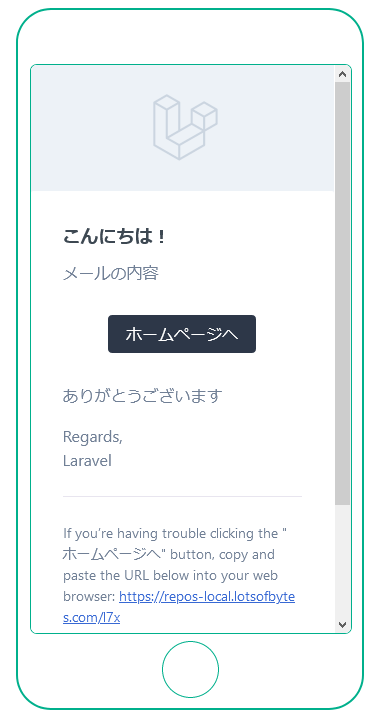前回はMailableを使ってのメール送信の話でした。今回は、もう1つLaravelからメールを送信する方法としてNotificationの話です。
Notificationを使用してメールを送信
Mailableを使ってメールを送信するには、
use App\Mail\SomeMailableClass;
Mail::to("test@example.com")->send(new SomeMailableClass);
が典型的な送信の仕方です。
一方、今回紹介するNotificationは、Notifiableのトレイトを使ったモデルクラスにメールを送信する機能を与えます。
例えば、このようにUserのクラスにNotifiableを追加すると、
namespace App;
use Illuminate\Contracts\Auth\MustVerifyEmail;
use Illuminate\Foundation\Auth\User as Authenticatable;
use Illuminate\Notifications\Notifiable;
class User extends Authenticatable implements MustVerifyEmail
{
use Notifiable;
..
}
以下のように、Userのモデルのインスタンスのメソッドとして、notify()でメールを送信できます。
use App\User; use App\Notifications\Hello; $user = User::find(1); $user->notify(new Hello);
上では、$userのオブジェクトの項目である、$user->emailが自動的にメール送信の宛先となります。
さて、送信するメールの内容の方は、Notificationのクラス(上ではHelloのクラス)の作成が必要です。
$ php artisan make:notification Hello
を実行して、作成されたファイルを以下のように編集します。
namespace App\Notifications;
use Illuminate\Bus\Queueable;
use Illuminate\Contracts\Queue\ShouldQueue;
use Illuminate\Notifications\Messages\MailMessage;
use Illuminate\Notifications\Notification;
class Hello extends Notification
{
use Queueable;
/**
* Create a new notification instance.
*
* @return void
*/
public function __construct()
{
//
}
/**
* Get the notification's delivery channels.
*
* @param mixed $notifiable
* @return array
*/
public function via($notifiable)
{
return ['mail'];
}
/**
* Get the mail representation of the notification.
*
* @param mixed $notifiable
* @return \Illuminate\Notifications\Messages\MailMessage
*/
public function toMail($notifiable)
{
return (new MailMessage)
->subject('こんにちは')
->greeting('こんにちは!')
->line('メールの内容')
->action('ホームページへ', url('/'))
->line('ありがとうございます');
}
/**
* Get the array representation of the notification.
*
* @param mixed $notifiable
* @return array
*/
public function toArray($notifiable)
{
return [
//
];
}
}
さてtinkerで送信してみます。
>>> $user = User::find(1);
[!] Aliasing 'User' to 'App\User' for this Tinker session.
=> App\User {#4072
id: 1,
name: "test",
email: "test@example.com",
email_verified_at: null,
created_at: "2020-12-30 23:14:29",
updated_at: "2020-12-30 23:14:29",
}
>>> $user->notify(new App\Notifications\Hello);
=> null
MailTrapで送信したメールを見ると、

もうすでにHTMLのメールとなっています。
以下のように、文言はすべてMailMessageのクラスのメソッドで簡単に与えるだけOKです。
上の例で、まだ英語として残っているRegards, Laravelの部分を変えたいなら、以下のように、salutationのメソッドに引数を渡します。
...
public function toMail($notifiable)
{
return (new MailMessage)
->subject('こんにちは')
->greeting('こんにちは!')
->line('メールの内容')
->action('ホームページへ', url('/'))
->line('ありがとうございます')
->salutation('Larajapan');
}
..
送信メールをカスタマイズ
もっとHTMLメールをカスタマイズしたいなら、以下を実行してデフォルトのブレードを自分のプロジェクトのディレクトリに出力します。
$ php artisan vendor:publish --tag=laravel-notifications Copied Directory [/vendor/laravel/framework/src/Illuminate/Notifications/resources/views] To [/resources/views/vendor/notifications] Publishing complete.
作成された、email.blade.phpは以下のようなマークダウンのブレードです。Laravelのコンポーネントとマークダウンのシンボルが混ざっていて少しわかりづらいですが、上で使用されたメソッド名がブレードでは変数名となっているのがわかります。line()に関してはボタンの表示を境に上と下で、$introLinesと$outroLinesに分かれます。
@component('mail::message')
{{-- Greeting --}}
@if (! empty($greeting))
# {{ $greeting }}
@else
@if ($level === 'error')
# @lang('Whoops!')
@else
# @lang('Hello!')
@endif
@endif
{{-- Intro Lines --}}
@foreach ($introLines as $line)
{{ $line }}
@endforeach
{{-- Action Button --}}
@isset($actionText)
<?php
switch ($level) {
case 'success':
case 'error':
$color = $level;
break;
default:
$color = 'primary';
}
?>
@component('mail::button', ['url' => $actionUrl, 'color' => $color])
{{ $actionText }}
@endcomponent
@endisset
{{-- Outro Lines --}}
@foreach ($outroLines as $line)
{{ $line }}
@endforeach
{{-- Salutation --}}
@if (! empty($salutation))
{{ $salutation }}
@else
@lang('Regards'),<br>
{{ config('app.name') }}
@endif
{{-- Subcopy --}}
@isset($actionText)
@slot('subcopy')
@lang(
"If you’re having trouble clicking the \":actionText\" button, copy and paste the URL below\n".
'into your web browser:',
[
'actionText' => $actionText,
]
) <span class="break-all">[{{ $displayableActionUrl }}]({{ $actionUrl }})</span>
@endslot
@endisset
@endcomponent
もちろん、前回のように独自のマークダウンのブレードを作成して利用することも可能です。その場合は以下のように、markdown()メソッドにブレード名を入れます。
...
/**
* Get the mail representation of the notification.
*
* @param mixed $notifiable
* @return \Illuminate\Notifications\Messages\MailMessage
*/
public function toMail($notifiable)
{
return (new MailMessage)
->subject('こんにちは!マークダウン')
->markdown('emails.hello-markdown');
}
...
